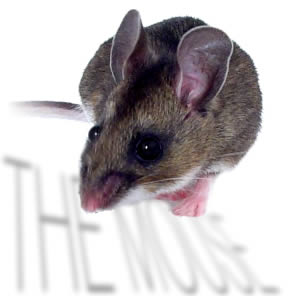History
Originated in the steppes of Central Asia.
Reportedly found in this country as early as the 9th
Century, when and how will continue to remain
unsolved.
Certainly as agricultural practices improved man's
harvests,the need for greater storage facilities were created thus providing more food and nest sites for mice and rats.
Habits
M. domesticus will drink water if available but can survive on food with a moisture content of 15%. It is omnivorous, feeding from a number of different points.
Whole wheat, which has been partly eaten by mice, has a kibbled appearance whilst whole grain, partly eaten by rats, has a cut or chopped appearance.
Color Brown to grey with a lighter underside
Ears Large
Eyes Small
Tail Slightly less than body length
Weight (adult) 10 - 25 g
Litters per year 5 - 8
Litter size 4 - 8
Maturity 6 - 8 weeks
Average life span 3 - 4 months
Vertebrate Pestfiles (rodent)
Rodent Control Methods
General tips for rodent monitoring and control program are given in this section.
Prior to carrying out treatment against rats or mice, a thorough inspection or survey of the property, site or area should take place to decide on the extent and size of the infestation. Adjoining areas should also be included in this survey (as rodents may travel from other areas to feed or drink then return to a harborage).
The following covers the basic points to consider including protective equipment. During the survey, the survey or operative should also be undertaking at least a mental risk assessment, in some circumstances using a check/tick box risk assessment to cover hazards that are found on site. Any factors that the client or property owner can do to improve the situation should also be noted. For instance, housekeeping, stacking, proofing and cleaning etc all form part of an integral control program.
Protective equipment requires is as follows: Gloves, coverall, suitable footwear and a hard hat for the survey, if in ducting or roof spaces. Additional equipment that may be required include a torch, notebook and tracking dust.
Obtain as much information as possible from people on site and use this information when conducting the survey. Try and put the information gained into context whilst on site, remembering that people may exaggerate and may also pass on second-hand information that may be incorrect.
Armed with the background knowledge of biology and behavior, look for signs of rodents. These will include:
Holes Droppings
Runs Smear marks
Damage Tracks
Nests Dead and live rodent
A further characteristic is smell. Rodents produce a distinct odor in nests sites and harborages that once experienced will not be forgotten.
Baiting techniques
Following the survey, (having established which species is present) a baiting program should be established. The dilemma that faces the operative is to present a rodenticide to the rodent without endangering non-target animals or man. Each infestation will not only be different but will change daily, even hourly in this aspect and this should be taken into consideration when carrying out the site assessment.
With these points in mind, the baits should be out of site and not accessible if at all possible, consideration should be given to using tamper-resistant bait stations.
Examples of baiting locations
Domestic (Mice)
Areas favored by mice are food storage and preparation areas such as kitchens and pantries. Airing cupboards, sub-floor areas, enclosed pipes and baths in bathrooms and loft areas are also favored areas. Safeguarding baits in a domestic location will always be a high priority, therefore always consider using tamper-resistant bait stations. These can be placed under or behind kitchen fittings, behind fridges, under kitchen units, behind the bottom drawer of the cooker etc. In airing cupboards, they can be placed behind the tank and in a large majority of cases, under the floor boarding. If baits are to be used in bathroom areas, bath panels can be removed and baits placed under the bath itself. Loft areas usual present a low risk of accessibility from non-targets and often cardboard bait boxes or even open trays are used. If in any doubt, use tamper-resistant bait boxes in these areas also. It is important to remember that mice feed from many different places during the course of a nights feeding. Control will therefore be achieved by placing a large number of small bait points rather than fewer bigger bait points. In a domestic situation, if tamper-resistant baits may be disturbed, block formulations will reduce the risk of contamination by spillage.
Domestic (Rats)
Preferred areas are as for mice. Harborages are usually sub-floor and loft areas, therefore baited laid in these areas should have little likelihood of being accessed by humans and non-target animals. If at all possible, use the larger tamper-resistant rat bait boxes. Important considerations in domestic rat infestations are how the rats gained access to the building. Proofing may well be required. If no proofing faults are found then a drain/sewer fault needs to be explored and rectified. Adjacent premises should also be checked for proofing and/or drain faults. Remember that rats are reluctant to nest indoors.
Farms (Rats and Mice)
Farms come a large number of different shapes and sizes. In general, living accommodation will be an integral part of the site so that children and domestic animals must also be considered. Stored animal feed and crops, bedding, even animal waste will present an ideal environment to support a rodent infestation. Rodents living and feeding outside will enter buildings with the onset of the winter months.
Mice living indoors should be treated using bait stations placed in safe locations if accessible, and if contamination from spillage is a hazard, blocks within tamper-resistant stations should be used.
Rats need ready access to a water supply as they must drink daily. Runs to the water source may be evident and give an indication of harborages. These may be evident as holes and if holes can themselves be baited safely, this should be done. To reduce the risks of non-targets, cover the holes with materials found in the location; stones, wood, etc. Covering holes will also have the advantage of keeping the baits dry, keeping them palatable for longer. Ideally, the bait point should be at least 60cm down the hole to prevent children reaching the bait. To protect farm buildings, external bait points should be established. These may be on the outer perimeter of the site as a whole and could also include the perimeter of each building. Fixed tamper-resistant bait stations for these locations would give the highest level of protection.
This must be determined during the survey and assessment. Internal bait points should be placed near to the source of the infestation without risk of contamination to animal feed or stored crops and in locations where poultry and other animals cannot gain access to them.
Food Premises (Rats and Mice)
Concern in these locations is the risk of spillage and the resultant risk of contamination from the spilled rodenticide. This risk will overcome by the use of formulations. In very sensitive areas indicator blocks (non-toxic blocks) can be used contained within tamper-resistant bait stations (both for rats and mice). These are particularly useful.
Internal bait points should be kept to a minimum and reduced once an infestation has been cleared. Fixings to walls and floors is desirable and far safer in production areas. Away from production areas, boiler rooms, false roofs, etc, are high risk and should be baited. Perimeter baits, if appropriate for the location, should be established. These should be of a fixed tamper-resistant type to give the highest level of protection to the bait. Internal locations of bait points in restaurants, kitchens etc, should be as for domestic premises.
In many premises, baiting of production areas is not permitted.
Follow-up
The usual follow-up time after the initial baiting program has been established is seven working days, although some situations may require daily visits.
Unless the bait stations are left in position as part of pest control contract, on completion they should all be removed.
So locations will merit detailed reporting systems to include bait plans, monitoring reports, and hygiene, housekeeping and proofing recommendations.






